Archive for ‘General’ Category
Morning, Noon and Night: A Day of Fun Alternatives to Paper
Granted, I was attending the birthday party of a two-year-old and was surrounded by tiny humans who couldn’t have cared less about my presence (except when I was holding up the line for birthday cake), but it’s always fun to observe them in their natural habitat. They communicate in their own foreign (as much to one another as to us) dialects, greet one another with hugs or bonks on the head, and toddle off in their own personal planetary rotations. There’s no “Let’s do lunch”, no “I’ll friend you if you’ll follow me”. Perhaps it’s an unrefined sense of object permanence, but toddlers have no need to set in motion future contact; nor do they need to fix their brilliant ideas in permanent form. They really have no need for paper. Not so with giants.
Near the end of the event, one of the grown-up attendees wanted to trade contact information. I offered my card, but she had none of hers with her. Absent any note paper, this lovely woman found the quickest solution — she grabbed a crayon and scribbled her information on a party napkin.
Sure, many people have those cell phone apps that allow them to Bump their phones together to exchange information. And, of course, we normally get through our days using numerous technological solutions that replace tasks we once performed with paper.
But this got me thinking about the situations in which we find ourselves where there isn’t necessarily a technological alternative to paper. There are times when we’re away from our desks, our offices, our notepads, computers and gadgets, or caught with our hands otherwise occupied. There are times when technology can’t come to our aid, and there’s no paper in sight…or sometimes we just want a fun alternative.
Today, we’ve got a few unconventional ways to organize our thoughts and information without benefit of technology or paper.
Waking Up: Remember the Essentials…While You Lather. Rinse. Repeat.
Paper Doll gets the best ideas for blog posts while in the shower. Sometimes I use Dale Carnegie’s refined mnemonic Pegging Method for remembering things until I can get toweled off, but I often wish I had a voice-activated recorder or just a better way to take notes in the shower.
Some of my friends with children have been known to use their kids’ washable Crayola Bathtub Crayons  on the shower walls to capture brilliant ideas, but the word on the (Sesame) street is that the crayons tend to melt into nothingness if left in water too long.
on the shower walls to capture brilliant ideas, but the word on the (Sesame) street is that the crayons tend to melt into nothingness if left in water too long.
Let’s face it, reaching a dripping hand out of the shower to write on toilet paper with an eyeliner pencil isn’t exactly optimum. As an alternative to paper, I have to admit I’m enamored by the idea of the Erasable Shower Note Tablet from eTravelGear:
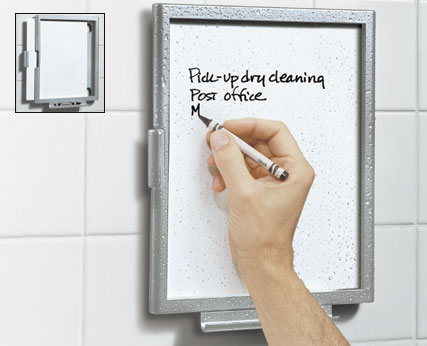
Use the enclosed waterproof crayons to jot down your To Do items, song lyrics, or even messages for the next person in the shower. The tablet includes a crayon caddy to keep your writing implements handy and affixes to the shower wall with suction cups. (Note, suction cups’ suction success (say that three times fast!) varies by shower wall type (e.g., tile, ceramic, glass, plastic, etc.). If your best ideas strike you just as the hot water hits your scalp, or you’ve ever kicked yourself for letting your moment of inspired genius spiral down the drain along with the Clairol Herbal Essences, this tablet might be your saving grace.
Writing on the mirror with lipstick would probably make you feel like an extra in a horror film (and would ruin a perfectly good lipstick), but various sources report that you can safely use a dry erase marker on glass and mirrors. If your beautiful mind beholds the mathematical answers to the universe while you’re shaving or drying your hair, the dry erase marker offers a nifty one-handed solution. Later on, copy to paper or snap a digital photo, and when you’re ready to move on, make your messages, artwork or equations disappear with a dry erase eraser or paper towel. (Of course, be sure to test any dry erase marker on a tiny, not-so-visible portion of the shower door, window or mirror, and don’t dare try this with antique glass.)
Finally, not so much a paper alternative as an alternative kind of paper, AquaNotes has created a waterproof notepad so durable you can even write on it underwater. Each perforated sheet is 3 1/2″ by 5 1/4″, and the 40-sheet pads are recyclable and printed with soy-based ink. AquaNotes attaches to the shower wall with suction cups.
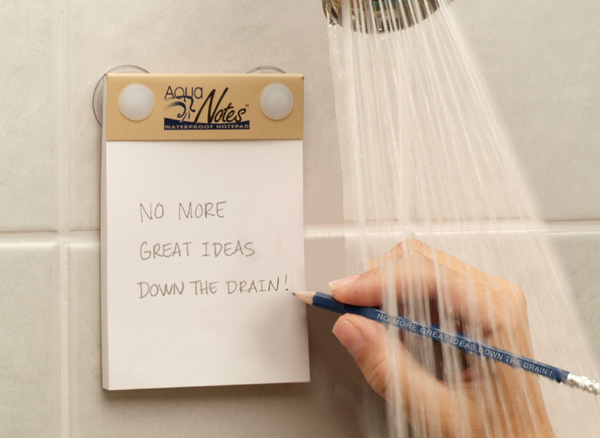
Plan Your Afternoon During Lunch
Do you ever thirst for better time management when you’re in the middle of a meal?
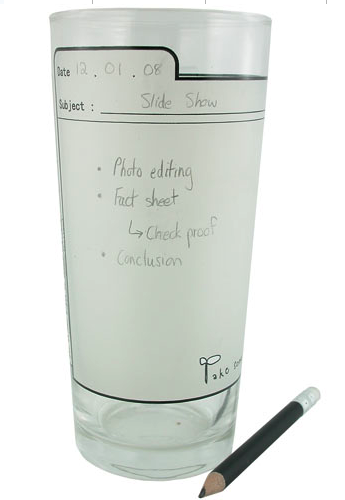
 smaller mug version, but it seems you have to contact Made By Humans directly to purchase the mug in lieu of the glass.
smaller mug version, but it seems you have to contact Made By Humans directly to purchase the mug in lieu of the glass.
On the Run and Having Fun
More than a few people, famous and otherwise, have caught the public eye when solving the “no paper” problem by writing on themselves. If you’re inclined to write on your hand, but wish for a smudge-free alternative, the To-Do Tattoo from Fred & Friends offers a whimsical yet eminently practical solution.
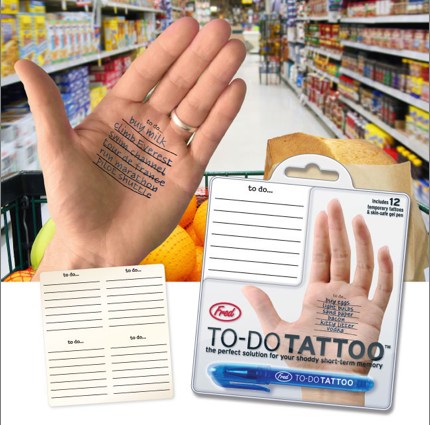
Each package includes a dozen transparent, skin-safe, adhesive “To Do” forms, ready to adhere to your hand (or wherever else you’re likely to need your notes). Just write your reminders with the enclosed washable-ink gel pen, tackle your To Dos and dispose. For the truly forgetful, this isn’t a particular cost-effective solution, and Paper Doll wishes it could go without saying that To-Do Tattoos should not be used in lieu of studying for that geometry quiz.
Family Communication Isn’t Too Cool for School
We tend to think of squeaky chalkboards as the province of the academic world, and there’s very little call to turn your garage or mud room wall into a classroom. However, you can take a page out of your grammar school dcor textbook to find a super paper-free communication alternative for your family.
Pick up some chalkboard paint from your nearest home supply store. Although Crayola’s chalkboard paint has been discontinued, Rustoleum, Krylon, and Benjamin Moore all still manufacture it, and you needn’t settle for Schoolroom Green. Colors come in stony black, rich red and a variety of other fun shades.
Next, pencil-sketch your measurements, use painter’s tape to delineate the borders and paint a small portion of your wall. Once it’s dry, keep a bright supply of art chalk in a plastic bucket so that the whole family can leave reminders and alerts: “Tomorrow is trash day!”, “There’s broken glass in the kitchen!”, “We love you, Daddy!”, “Welcome Back!” and so on.
If you’re not a Do-It-Yourselfer, instead of painting a chalkboard, consider peel-and-stick chalkboard cutouts from Wallies, ranging in size from super-sized for calendars:
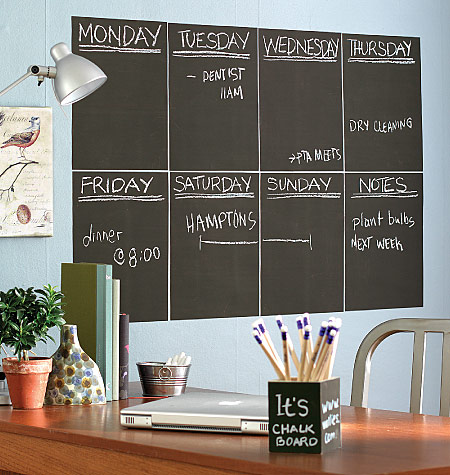
to cozier decorator styles:
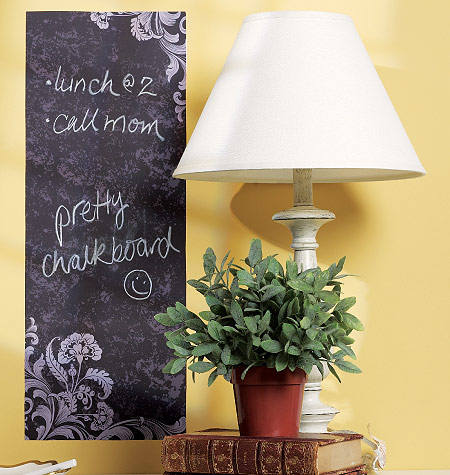
Wallies also carries various dry erase peel-and-stick removeable/repositionable options.
Leave A Bedtime Reminder
If you and your beloved sleep on separate shifts, you may find yourselves communicating more often by note than in person. A somewhat impractical but quite charming paper alternative is the Note Me Pillow from Veinticuatrodientes.
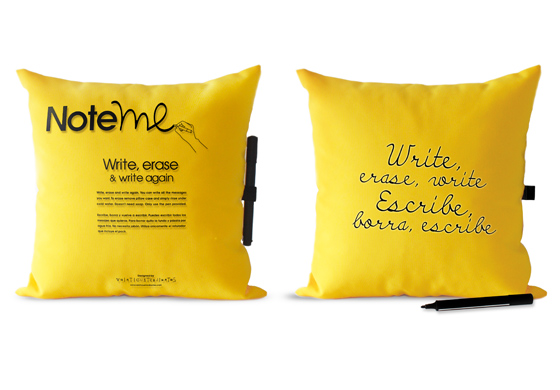

Simply write your message on the colorful pillowcase with the enclosed pen. (“Honey, please make sure the doors are locked and the lights are out before you go to sleep!”) To erase, just run the pillowcase under cold water — no soap necessary. The pillows come in yellow, red, orange, white and green.

The web site for Veinticuatrodientes, Spanish for “twenty-four teeth”, says, “When you put your biggest smile in your face, the most you can show is twenty four teeth.” Paper Doll assumes one could easily write more smile-inducing messages on these tablets, showers and mirrors, chalkboards and pillows, than mere quotidian To Do lists and household reminders…but this is a family blog, so I’ll leave that to your individual imaginations.
Paper Doll Stops and Smells the Paper Roses
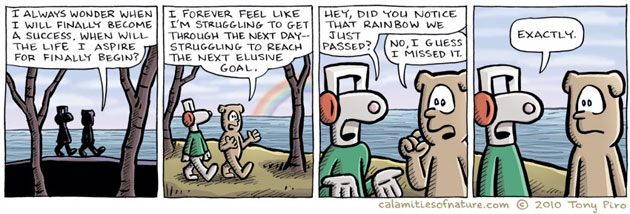
(With huge thanks to Tony Piro for making Calamities of Nature available for distribution among fans, and especially for solving my technical difficulties in getting this particular strip to conform with OnlineOrganizing.com’s fun margins.)
Organizing is a journey, not a destination, and sometimes we need to pull over for the scenic view. Readers, this week, Paper Doll is taking time to stop and smell the paper roses, so I can return to you refreshed, revitalized and ready to tackle all the paper organizing topics of which you’ve ever dreamed (and some of which you’ve never imagined).
While I’m away from the computer for a few days, I encourage you to check out a few of my favorite blogs on organizing, time management and productivity. Most of these people are prolific bloggers, so you’ll have plenty to peruse in my absence, and all of them are wise, wonderful and witty.
Janine Adams’ Peace of Mind Organizing
Ramona Creel’s Who Wants To Get Organized?
Jeri Dansky’s Jeri’s Organizing and Decluttering News
Erin Doland’s Unclutterer
Nanette Duffey’s Piggy Bank Pixie Picks (try saying that three times fast)
Ann Bingley Gallops’ Open Spaces Feng Shui
Aby Garvey’s Creative Organizing Blog
Craig Jarrow’s Time Management Ninja
Brandie Kajino’s SOHO Solutionist
D. Allison Lee’s Organize To Revitalize
Lorie Marrero’s The Clutter Diet
Monica Ricci’s Your Life. Organized.
Rubbermaid’s Adventures In Organization Blog
Geralin Thomas’ Managing Modern Life
I hope to see you all back here next week! Until then, keep organizing, but remember that organizing is only a means to an end. Organizing your paper (and your home, office, car, purse, schedule and life) gives you more time to spend with the people you love, doing the activities about which you are passionate. Take time to smell the roses and keep watch for those (double) rainbows.
Safeguard Your Very Important Papers: Safe Deposit Box Basics
Paper Doll worries about your VIPs — your Very Important Papers. Usually, we talk about what those VIP documents are, how to locate them, and where to keep them (generally speaking, in terms of filing hierarchies). But what about the safest places for your VIPs? Today, we’ll be talking about safe deposit boxes.
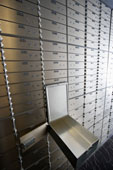
YOU MIGHT NEED or WANT A SAFE DEPOSIT BOX…IF:
–You want to keep track of where your vital documents are located and want them all in one central and safe location.
–You want a completely private location in which to store and review your documents or possessions. (Image how different Mad Men‘s Don Draper’s life would have been if that top desk drawer hadn’t been tempting Betty with its secrets!)
–You want your loved ones to have easy access to important documents even if you are unavailable (traveling, ill, etc.)
–You want to protect your important documents (and possibly other possessions, such as fine jewelry, coin collections, medals, photographs, and written or photo/videographic home inventories for insurance purposes) from theft, fire, flood or natural disaster.
–You recognize that most home safes portable enough for you to take with you during a disaster would also be portable enough for thieves to carry away into the night and that the combinations aren’t generally very hard for thieves to crack.
–You have family heirlooms and precious documents that are too delicate to be left in the open in a home where children, pets and others could cause damage.
–Your insurance company may discount your homeowner’s insurance if you notify them of the use of a safe deposit box for valuable assets. Most (but not all) insurance policies will cover the value of possessions stored in a safe deposit box. Call your agent to ensure you have all the protection you need — and are given all the discounts you deserve.
YOU MIGHT NOT NEED or WANT A SAFE DEPOSIT BOX…IF:
–You’re comfortable scanning your documents (to a hard drive or flash drives stored off the premises or to a storage site in the cloud, like Dropbox) and aren’t that worried about maintaining the originals. Some people don’t worry that much about fire, flood or theft and have so few vital documents that they are willing chance the cost of replacement fees.
–You relocate often due to your family, work, academic or volunteer obligations.
–You can’t afford safe deposit box rental prices.
–You hate banks and credit unions, prefer to live off the grid and don’t want “The Man” to know where you are or what documents you possess.
If any of these apply to you, a portable fireproof, waterproof safe might satisfy your needs. However, as noted above, such safes can be easily purloined and cracked.
HOW TO RESEARCH A LOCATION AND BOX
Take some time to do your research to determine the best safe deposit box solution for your needs.
1) Select a bank branch convenient to your home or work — Many full-time workers can get away to the bank on their lunch hours, but might not be able to access the bank as conveniently from home. However, if your spouse will be more likely to access the box than you, having it close to his/her office, or closer to home, might make more sense. Think about when you’ll want to access the box, either for retrieval or for putting items in.
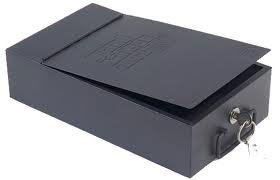
2) Compare prices — Generally, it makes sense to get a safe deposit box at your own bank, as customers get discounted pricing.
Also, consider how big a box you need, as rental rates vary by size (from $15 to a few hundred dollars per year). While the depth of safe deposit boxes are standard (generally about 18-22 inches), the height and width dimensions come in multiple categories. The smallest boxes are usually 3″ x 5″, but unless you have very few documents, you’d have to roll your papers to make them fit. Medium boxes range from 3″ x 10″ to 10″ x 10″. The largest safe deposit boxes in consumer banks tend to be about 15″ x 15″, though larger specialty boxes can be arranged at banks that cater to clients who have large financial holdings.
3) Ask about policies and fees. What are the key replacement fees? What are the charges for drilling boxes if keys are lost? Is there comfortable (or any) seating available in the vault, in case you need time to go through the contents of your box and need to sort documents?
HOW TO RENT A SAFE DEPOSIT BOX
Decide whether you want to share access with someone else: your spouse, parent(s), child(ren), business partner(s) or friend(s). You can’t just designate someone as a co-owner and give them a key. They’ll have to sign the signature card and show photo ID — both at the time of rental and to gain access.
If you don’t intend to share, make the time to designate a Power of Attorney or agent to act on your behalf for financial and other urgent matters if you’re ever unable to access the box yourself. However, designation of a Power of Attorney ceases upon your death. Eventually, the executor of your will can gain access (depending on the probate and estate procedures of your state), but this can be a lengthy process. Some states will allow you to create a temporary executor clause to speed the process, but regulations are not uniform in this regard. You can, however, appoint a trustee to oversee any of your assets you place in a trust; the trustee can then access the box after your death. Complicated? Very. If your possessions and documents are relatively simple, you’re probably better off naming as co-renter someone in which you can place great trust (like Paper Mommy).
Make an appointment. No, it’s not essential, but you might feel better about setting an appointment to sit down with a bank representative to deal with the paperwork. Also, not all bank branches have available boxes. By calling ahead, you can determine whether you wish to be placed on a waiting list or will need to select an alternative branch. Be prepared to fill out some forms, sign a lease agreement and pay for the initial rental term. Make sure co-renters are available to come to the appointment as well.
Bring your photo ID. Co-renters should do the same.
Bring the items you wish to store. Before you leave the house or office, create an inventory list, and bring a copy of the list with you. As you place the items or documents in the box, check them off your list.
Bring your camera and take a photo of the items in the box. The date-stamped photo and list will help you keep track of what’s inside. (Take a photo and/or adjust your list when you add or remove documents or possessions.)
Bring a few zip-lock plastic bags for protecting items in case of floods or sprinkler system malfunctions. Most file folders will fit in gallon-sized bags. If you’re safeguarding delicate non-flat items (and your box is large enough) Tupperware or Rubbermaid food containers also afford protection from water damage. Put a label with your name and contact information inside the container so that items can be identified as yours in the aftermath of any disaster.

Keep your key somewhere safe and memorable. If allowable, make a copy of your key (or purchase a second, if one is not made available for free). Even if someone has your key, he or she should not be able to access your safe deposit box, as proof of identification and signature is required in tandem with a key. Key loss, however, may require drilling of the box — at prices exceeding $150.
OTHER CONSIDERATIONS
If you are a singleton and haven’t made arrangements for another person to have signature access, designate a Power of Attorney for financial issues. This way, if you are stranded abroad, disabled, or comatose, your loved ones will be able to help oversee necessary activities on your behalf.
Possessions can still be damaged or stolen. Faulty sprinkler systems, actual fires, floods and yes, even bank robberies, can lead to loss or damage of your items. This is why it’s necessary to maintain an inventory at home of the contents of your safe deposit box, just as you might keep an inventory of your possessions at home in the box.
The contents of your box will not be available 24/7/365. There’s a reason they’re called bankers’ hours — generally 8a – 5p, Monday through Friday, with some wiggle room on Saturday mornings and occasional late Friday hours. But banks are closed on federal (and some state) holidays, Sundays, and more than 12 hours of every day, from dinnertime to breakfast.
Access to your safe deposit box can be frozen. For example, if you are involved in a dispute with the Internal Revenue Service, the IRS can block your access. Also, if law enforcement officials (including the Department of Homeland Security) believe you and/or the contents of the box are related to illegal activity (drugs, guns, explosives, or illegally-obtained items), a court order can be issued to give law enforcement access to the contents of your box.
Your safe deposit box can be declared “abandoned” — if you stop paying your rental fee, maintain no communication with the bank, and nobody in your family or overseeing your estate is aware that you possessed the safe deposit box, the contents of the box will eventually be turned over to your state’s Unclaimed Property division. Make sure your loved ones or legal representatives know you have a box, where it is, and the location of the key.
WHAT YOU SHOULDN’T KEEP IN YOUR SAFE DEPOSIT BOX

Large amounts of cash — First, you’re not earning any interest. Second, cash is less accessible in your safe deposit box than in your bank account, from which you can at least make withdrawals or debit purchases. Third, cash (and any other assets) kept in your safe deposit box (as opposed to an actual account) won’t be protected by the Federal Deposit Insurance Corp., nor covered under FDIC rules. (Cash in your bank account is insured up to $250,000 per depositor per bank; cash in your box isn’t insured at all.) Currency is less likely to catch on fire or be accidentally thrown away than if you stored it in your mattress, but it is otherwise one of the worst things you can keep in the box.
Your will — If the only legal copy of your will is in your safe deposit box, unless you have a co-renter, your family will have to secure a court order to access the will…and the rest of the box…speedily. Whenever possible, your attorney should keep an original of your will; just keep copies in the box.
Anything you will need in an emergency — Obviously, this will vary widely by user. For most people, any international travel comes after months of planning and preparation. However, if you work for a multi-national corporation that flies you around the world at a moment’s notice, or if you’re an international spy, you probably aren’t going to want to wait until the Tuesday morning after a federal holiday to run into the bank to get your passport. (Or, y’know, passports (plural), if you’re a spy.)
Original, sole copies of vital documents that your family might need if you become incapacitated — If you are the only person to have access to your safe deposit box and you have not designated someone as having Power of Attorney (or have stored the only existing copy of the Power of Attorney paperwork in the box), lack of access to an original of your living will/medical directives and other life or end-of-life instructions could create major problems. In general, if the original or any document (other than your will) is going in the box, keep sharp copies at home (or in the cloud).
There are a variety of sources online to help prompt you regarding what documents you might want to keep in your safe deposit box, including my ebook, Do I Have To Keep This Piece of Paper?, which identifies what documents need to be kept, how long to keep them and the best locations for doing so.
Not everyone needs a safe deposit box, but not knowing the facts isn’t a good enough reason to leave your papers unprotected. Be safe.
Happy 3rd Anniversary, Paper Doll Readers!
Paper Doll
strives, week in and week out, to keep these posts useful and entertaining. Long-time readers know how passionate I am about the research that goes into finding the information and the goofiness that goes into the writing — all to help you lead more organized lives. It’s exciting that after three years, we’re still going strong, and I’m thrilled to continue the anniversary tradition begun in 2008 and carried on in 2009.I’m proud of the in-depth projects we’ve done, like the six-week series on decluttering books, the four-part series on paper-related organizing products displayed at this year’s NAPO conference, the three-part series on organizing tax paperwork, Get Organized Month’s four-week series on paper control and organizing basics and last autumn’s super-sized six-part Who Knows Your Secrets? series about the agencies and organizations collecting paper trails on you and your financial life.
I’ve also loved researching and writing many of the one-off posts. Some were timely (like about the U.S. Census, the CARD Act and the need for new Puerto Rican birth certificates); others were timeless How-To posts, as in how to:
— replace Social Security statements
— go green with greeting cards and office supplies, or
— create document inventories
And of course, we had posts that mixed organization and fun, like those about organizing board game rules and fortune cookie fortunes.
Writing a blog requires inspiration, and I get that from you, my lovely readers, and from the wealth of ideas out there in the clutter piles and magazine articles and news stories I encounter. Usually, it’s easy to come up with a topic, but hard to remember that brevity (and not book-length posts) are the soul of wit.
Sometimes, however, writing a blog about paper is like being pecked to death by ducks, with motivational and technological frustrations at every turn. That’s why I like to use the anniversary post to share some of the paper-related delights that lift my spirits when I’m feeling less like a Paper Doll and more like a wastepaper basket.
Speaking of ducks, Paper Doll was thrilled to receive permission to share this charming original work by Canadian artist Mui-Ling Teh called 3 cm Family Swim:

If you’re not fascinated, double-check the scale of the ducklings. When I saw Mui-Ling Teh’s page of amazing miniature origami at her RedBubble store, I was charmed. For those of you already looking for 2011 wall calendars, please be sure to check out each spectacular month of her calendar pages. (My favorite is December’s Arctic Playground, but use the comment section to tell me what you liked best.) For those of you who like to be dazzled at Zazzle, note that Mui-Ling Teh has a Zazzle store at http://www.zazzle.com/muiling* (and yes, the asterisk is intentional…think of it like a smooch from a tiny origami duckling).
While some of the paper art that inspired me was as small as miniature origami, other items that caught my attention were larger than life, or at least life-sized. For example, Chilean artist Don Lucho’s Casa De Carton art installation drew clicks on blogs all over the world when he built an entire apartment out of cardboard and paper — furniture and dcor included:

From cardboard bathrooms (with handmade toilet paper) to kitchenettes with cardboard spatulas,
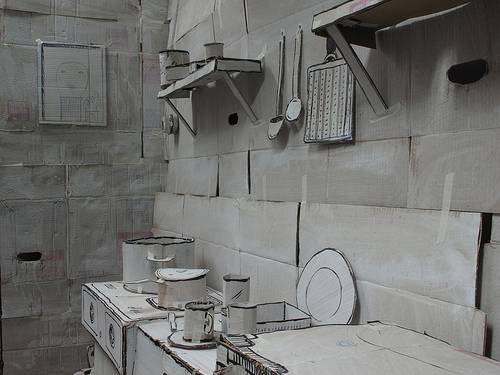
Lucho recycles packing materials into eco-art that wows the onlooker. For more of his projects, including a life-sized (but bloodless) cardboard auto accident, check out the posts at Pulpfactor and RebelArt.
In a blog that covers the gamut from recycling to conspicuous consumption, I’d be remiss to leave out Japanese artist Yuken Teruya’s work — he makes art trees out of the sides of the shopping bags in which his art is displayed! Be sure to click on each of The Saatchi Gallery’s Yuken Teruya works, from a McDonald’s take-out bag to the Louis Vuitton shopping bag below:

(Since last year’s anniversary post covered paper art shoes, it’s nifty to present the art of shoe bags. Next year, who knows? Shoebox art?) Be sure to check out the colorful Le Bon Marche bag and the stunning Marc Jacobs bag!
So, what might have come out of those shopping bags? While there were numerous newspaper-based dresses from the eco-fashion designers at last month’s Green Catwalk Event in New York City, Paper Doll feels that nothing they created is as stunning as the Louise Goldin paper dress created for Coutts & Co. in London:

(Curious about how it was constructed? There’s a video!)
Given that we’ve just finished a six-part series on book-related paper, the whimsy of UK papercut artist Su Blackwell requires a spotlight:

Talk about fairytales coming to life! Paper Doll is a huge fan of Jasper Fforde’s witty Thursday Next series (starting with The Eyre Affair), where “real-life” people can jump into books and interact with literary characters. Don’t you wish you could join this tea party? Blackwell’s visually arresting papercut art spans the literary spectrum from Alice to Peter Pan to Narnia. I can’t stop looking at her Woodcutter’s Hut:

It’s a temptation to cross the Atlantic to see Blackwell’s current Remnants exhibition at the Bront Parsonage Museum in Haworth (through the end of November). Can’t travel? Be sure to visit Blackwell’s site to view other book sculptures, installations and amazing commercial projects.
Papercut artist Rick Jones captivated me first with the title, Small Gods of Domestic Chaos, and then with the artwork, itself:

And what could be more domestic than the scenes created by Anastassia Elias, who crafts miniature worlds inside toilet paper rolls. Her three-dimensional Rouleaux projects miniaturize, with depth and clarity, tableaux raging from tango lessons to classroom studies, a visit to the zoo (and specifically, the giraffe pen) to sports scenes, and even laundry day:

Andrea Dezs was born in Transylvania, lives in Queens, NY, and creates for a world beyond imagination. She came to my attention through a New York Times article which displayed, among other pieces, a colorful painting of Star Trek-like aliens in leotards and deelyboppers. But her papercuts and silhouettes, from the political to the commercial (including an album cover for the Dixie Chicks spin-off group, Courtyard Hounds) to the “What is…oh my…will you look at that?!” are particularly captivating. This piece is one of multiple companions to Richard Rodriguez’s Final Edition: Twilight of the American Newspaper that ran in Harper’s Magazine in 2009:
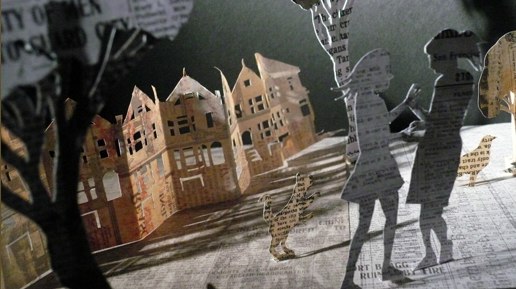
For you left-coasters, Dezs’s exhibition at San Francisco’s Frey Norris Museum goes through November 6, 2010.
This week, we are fanciful. Next week, Paper Doll will begin a fourth year of focusing on organizing paper to save you time, money and effort. Until then, please celebrate the entertainment value of paper. Meanwhile, I’m headed off to learn how to create a papercut city skyline for my paper dolls.
Thank you for three wonderful years!
Reducing Book Clutter (Part 6): Audio Books
There’s an ineffable quality to the warm memories brought on by that simple request. For most of us who love books — who love reading — the joy of the written word started with the joy of the spoken word. Amid “Once upon a time” and “In a land far, far away,” we developed our need to hear “just one more”. Stories warm our hearts and give our souls something to savor. It’s no wonder that we readers fill our spaces with books until every nook is overflowing.
In the first four installments of this series, we covered ways to reduce the clutter of books by changing the method of acquisition: renting books for adults and children, swapping books via web sites and borrowing from the library. Last week, we turned to changing the actual formats of books to help reduce clutter — via ebooks. In our final installment, we’re looking at listening…to audio books.
ADVANTAGES
Low-clutter — From an organizational standpoint, audio books reduce clutter because of how little actual space they need. Books on cassette offered little organizational advantage–in fact, one book (even abridged) required multiple cassettes. Books on CD slowly replaced tapes, and though CDs are compact and take up less space than tapes, they don’t dramatically reduce the pile-up. However, CDs can be ripped to .mp3 and other formats, so a book that takes up a dozen or more discs (which might get lost, separated from one another or stepped on) can be transferred to a computer, iPod or other audio player.
Portability — The ability to carry multiple books in digital format, whether on a computer or gadget, means never having to “weigh” your book options, literally or figuratively, whether you’re traveling around the globe or shlepping to the moon on your treadmill.
Affordability of Devices — While audio books, like ebooks, generally carry a cost, there is a decided advantage in the gadgets one may use to “read” audio. While the Kindle and Nook are priced in the hundreds of dollars, an .mp3 player can be had for as little as $10 (though, of course, most of us are tempted towards the pricier iPod line).
Paired Tasking — As a professional organizer, I eschew multitasking. You can’t effectively do two things at once if intellectual involvement is required for both. However, audio books let you do one thing that no other format allows — you can read when your hands and eyes are otherwise occupied. Audio books, particularly in digital format, let you commute (in your own vehicle or via public transportation), work out, travel, do housework or almost anything else that requires physical, but not mental, focus. Your eyes can be open or closed, your hands full or empty…and you never have to leave the story.
Interoperability of Formats — Burning a CD to .mp3 or changing from one format type to another is relatively simple and problem-free.
Immediacy — Although there aren’t currently any super-speedy sci-fi methods of acquisition along the lines of Amazon Kindle’s Whispernet, you can purchase an audio book (as a digital file) and begin listening immediately. No trip to the library or bookstore is necessary.
Environmental-Friendliness — The pressing and packaging of CD versions aside, audio book files require a relatively small carbon footprint.
DISADVANTAGES
The Voice — When you read, your imagination substitutes the voice type and vocal mannerisms, the verbal tics and aural characteristics of the characters in fiction. Even before you saw the big-screen versions of favorite books, you just “knew” how Mr. Darcy or Albus Dumbledore should sound. Most fiction audio books have one voice (sometimes the author, sometimes a famous actor, sometimes an unknown reader) relaying the story, and while audio book producers generally do an excellent job of ensuring that you know whether you’re hearing a character (and which one) or the narrator, the creative experience of reading is altered.
Of course, in another way, it’s very much the same experience as having a book read to you as a child, and that can make the experience enjoyable in an altogether different way.
The Feel — As referenced last week with ebooks, the tactile sensation of reading a traditional book is missing from the audio book experience.
Higher Costs of Books — Fewer people buy audio books than tangible books, decreasing the economies of scale of production. And, of course, it costs more to produce an audio book (with talent, directors and producers) than a traditional book. However, as digital formats don’t require storage or additional print run costs, we may anticipate increased price parity in the future.
No Reference Material — With fiction, the story is all. However, with nonfiction audio books, footnotes, end notes, reading lists, glossaries and other extras are generally lost.
No Searchability or Bookmarking — Audio books don’t just lack tables of contents and index material. With a traditional book, or even an ebook, you can manually or digitally search for text or phrasing or bookmark pages or sections. With an audio book, you can return to where you stopped, but you can’t quickly find specific passages or sections unless you a) have a counter and b) previously noted the counter position.
Impermanence — Although audio booksellers can’t steal back books sold after the final sale (as in our Orwell tale last week), two issues remain:
1) Technology Failures — A computer or gadget crash can damage your ebook library, and any titles you haven’t backed up. (So back up frequently!)
2) Changing technologies — Unlike the myriad ebook formats, there are relatively few popular audio book formats: .mp3, .wma, .ogg and .aac. Although CDs and digital files are hardier than tape, the lack of backward compatibility means that unlike a family Bible or favorite novel, it’s doubtful that anyone will pass down a library of .mp3s to their great grandchildren.
FREE AUDIO BOOKS
There are numerous sources for purchasing audio books, of which Audible (which offers a free 14-day trial) seems to be the most highly esteemed. However, as Paper Doll‘s mission is as much to help you organize your little green pieces of paper as it is to declutter your bookshelves, I’d like to review the least expensive options for acquisition:
Your Public Library — Many public libraries allow cardholders to “borrow” audio books. Peruse your library’s web site for references to NetLibrary or Overdrive, or search Overdrive to see whether your library is a member, providing DRM-free audio books. Depending on your library, there may be a limit on the number of audio books you can borrow concurrently. Downloads are “returned” automatically after a limited borrowing time.

Project Guttenberg – The Audio Books Project — The same Project Gutenberg we discussed last week, which offers thousands of public domain ebooks, has a wide variety of public domain audio books read by volunteers as well as texts read by computer. In English, choose from Aesop to Emile Zola; there are more than a dozen non-English languages with large collections, and a few dozen other languages, from Afrikaans to Yiddish, represented as well.

Learn Out Loud maintains a library of over 25,000 audio book titles, of which 2000+ are free. While most free audio book sites lean towards fiction offerings, Learn Out Loud concentrates on non-fiction — you’ll find a treasure trove of books on arts and entertainment, business, history, philosophy, politics, religion, science, self-development and more, downloadable for free in the .mp3 format. Place free titles in your shopping cart as if you are purchasing a book, place your order, then follow the steps to “My Downloads” to get your audio book.

Audio Books for Free isn’t the prettiest site on the web, but all of their titles are produced with professional actors/readers, directors and producers. Registration is required but free, and then you can search by genre and title, and even filter by language, play time, author, reader, and, if you’re a sensitive soul, filter out “strong language”, murders and adult themes. For a one-time $100 fee, you can gain access to higher quality audio formats.

Books Should Be Free offers hundreds of free public domain audio books suitable for the iPod or any .mp3 player. Classic titles are available in languages ranging from Ancient Greek to Urdu and in genres as varied as historical fiction, romance and sci-fi to humor, poetry, memoirs and religion. For each book, there’s a synopsis, a link to the Wikipedia entry, an audio preview and a link to the Project Gutenberg text version. (In the same vein as Charlotte Bronte’s “Reader, I married him”… Readers, I’m listening to Jane Eyre as I blog.)

Podiobooks delivers serialized chapters or sections of audio books by RSS, as if they were podcasts, to your iTunes or other podcatcher or RSS reader that handles embedded media. Alternatively, listeners can listen “live” or download episodes of books directly from the site, without any subscription. Unlike most free audio book sites, these titles are not out of the public domain, but are actually newer works. Some authors choose to make their books available for free to increase exposure, while others hope free audio versions will incline readers towards buying tangible copies, as well.

LibriVox is a non-commercial, non-profit library of free public domain audio books, but with a twist — books, even individual chapters, are read and recorded by users rather than professional actors or readers. You can subscribe to LibriVox’s thrice-weekly podcast to listen to the current book. Or, browse the entire catalog or search by author, title or genre to find what you want, then either download a zip file of an entire book or subscribe to it in iTunes. Listen through your computer, copy to your gadget of choice, or burn to CD. If the site’s goals intrigue you, consider volunteering to record yourself reading a beloved book or even a chapter.

Thought Audio is a small but growing free library of classic literature and philosophy texts in .mp3 format (available for live listening or free download). If you’d rather bypass the downloading of each segment separately (ideal for sequential listening or those with slow download speeds), a $10/year Zip Pass lets you download an entire (zipped file) book with one click.

Americana Phonic offers audio narration of American historical works and current government works in the .aac format. Make history come alive–for free. Haven’t you always want to do your yoga to a soundtrack of The Federalist Papers? (No? It’s just me? Sigh.)
Want more? Gizmo’s Freeware has a list of 64 sites for acquiring free audio books. Search by genre or by site name.
LOW-COST, LOW-TECH OPTION

Cracker Barrel — If you’re on the road a great deal and haven’t yet sprung for an .mp3 player, consider this novel approach for satisfying your literary cravings from the people who satisfy your biscuit and gravy cravings. Purchase a Book-on-Audio CD at any of their 400 locations in thirty-eight states. Titles tend to be new or recent releases. Listen, then return at ANY Cracker Barrel for a full refund (less a $3.49/week rental). Lather, rinse, repeat. For long-haul drivers, serious commuters and others who spend too much time in the car, this can be a fun, low-cost option that fosters a “one in, one out” approach for keeping the clutter of audio book CDs at bay.
I hope you’ve enjoyed this ramble through the various approaches to reading to your heart’s content while minimizing the tangible clutter of reading material. No matter where you acquire your books or in what format you devour them, Paper Doll wishes you happy reading!




Follow Me